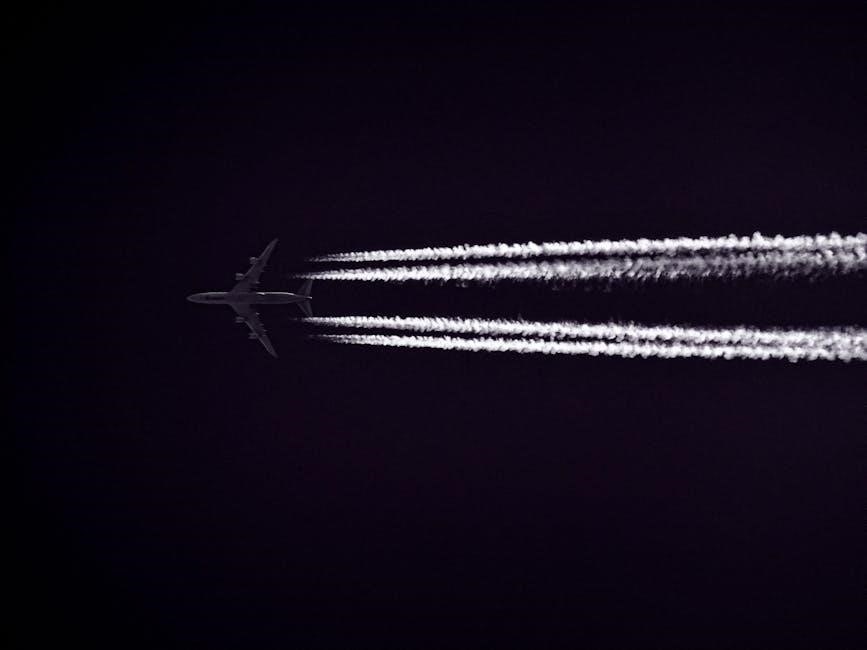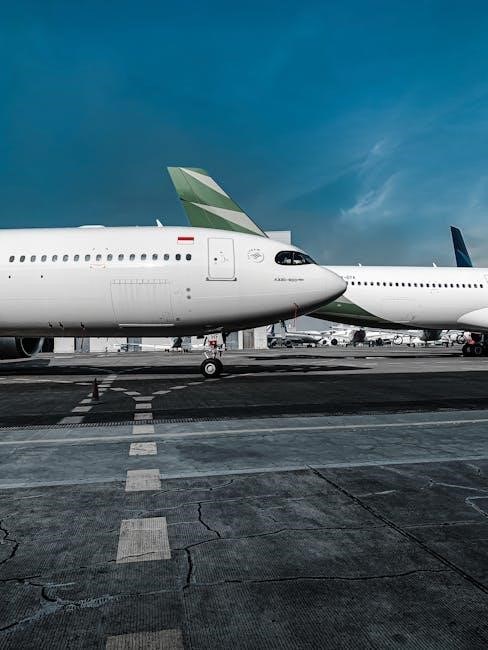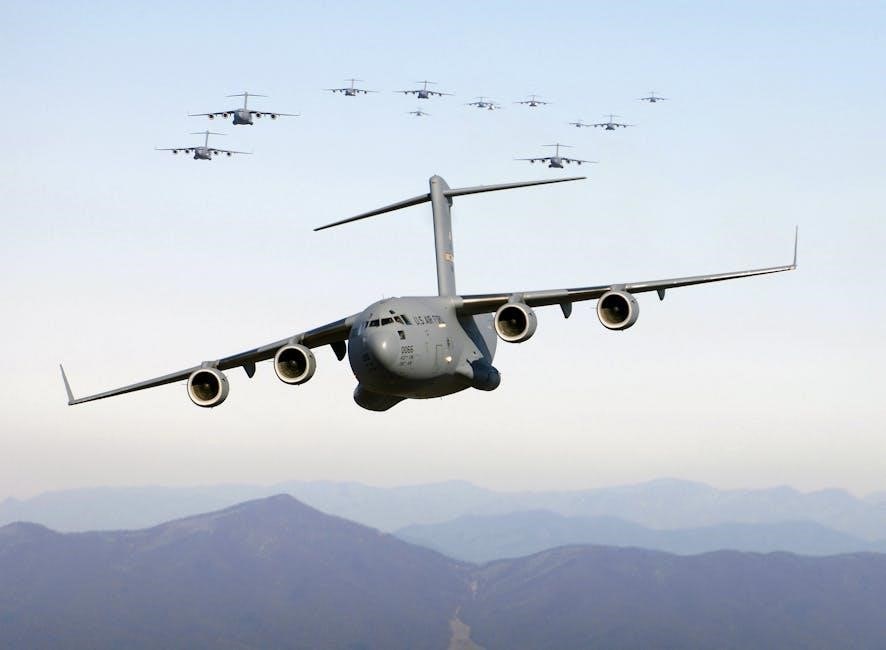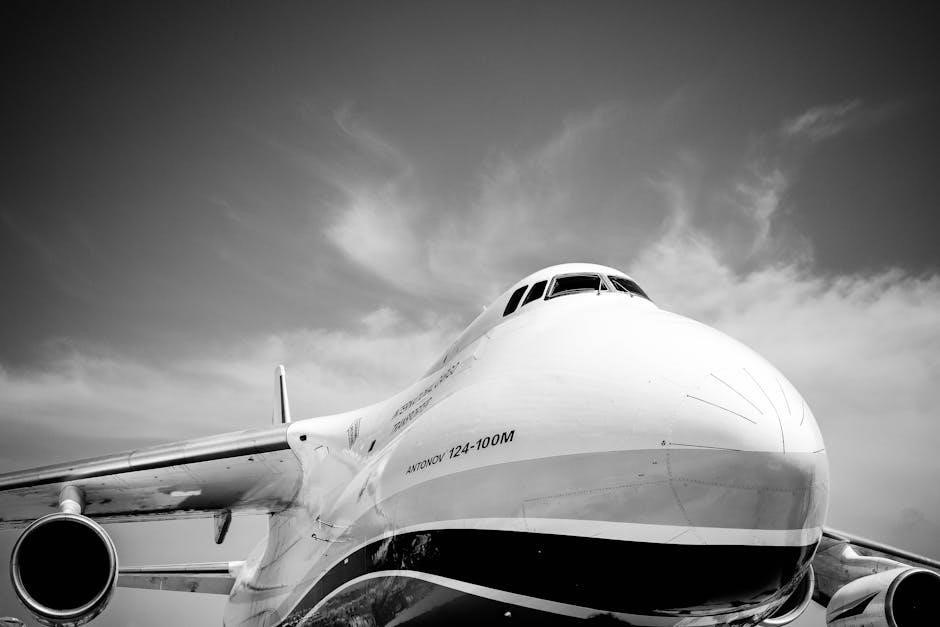Multi-engine flight testing is a critical process ensuring safety and performance in aircraft with multiple engines, essential for pilots and engineers to master for optimal aviation operations.
1.1 Purpose of the Guide
This guide provides a comprehensive overview of multi-engine flight testing, focusing on standardized procedures and best practices; Its primary aim is to ensure pilots and engineers can evaluate aircraft performance safely and effectively. The guide covers essential aspects, including pre-flight checks, takeoff configurations, cruise performance, and emergency protocols. It emphasizes the importance of understanding multi-engine systems and handling asymmetric thrust scenarios. By following this guide, aviation professionals can optimize flight test outcomes, enhance safety, and maintain compliance with industry standards. The content is tailored to address both theoretical and practical aspects, ensuring a holistic understanding of multi-engine flight testing.
1.2 Importance of Multi-Engine Flight Testing
Multi-engine flight testing is vital for ensuring the safety, reliability, and performance of aircraft with multiple engines. Unlike single-engine aircraft, multi-engine planes require specific techniques to handle asymmetric thrust and engine failures. Flight testing validates aircraft design, identifies potential issues, and ensures compliance with safety standards. It also trains pilots to manage critical scenarios, such as engine failure during takeoff or cruise. By evaluating performance under various conditions, multi-engine testing enhances operational efficiency and reduces risks. This process is essential for certification, pilot training, and maintaining trust in aviation systems. Without thorough testing, multi-engine aircraft would pose significant safety hazards, making this process indispensable to modern aviation.

Pre-Flight Preparation
Pre-flight preparation is essential for safe and effective multi-engine flight testing, involving thorough inspections, system checks, and planning to ensure optimal aircraft performance and crew readiness.
2.1 Understanding Multi-Engine Aircraft Systems
Understanding multi-engine aircraft systems is fundamental for effective flight testing. These aircraft feature complex systems, including fuel distribution, electrical, and hydraulic mechanisms, which differ significantly from single-engine planes. Pilots must grasp how each system operates independently and collectively to ensure safe and efficient flight. Familiarity with engine controls, propeller pitch, and fuel cross-feed systems is essential. Additionally, knowledge of system redundancies and fail-safes is critical for handling emergencies. This understanding enables testers to identify performance anomalies and optimize aircraft capabilities during flight trials. Proficiency in these systems is a cornerstone of successful multi-engine flight testing and ensures both safety and accuracy in evaluating aircraft performance.
2.2 Pre-Flight Checks and Inspections
Pre-flight checks and inspections are critical for ensuring the safety and performance of multi-engine aircraft. Pilots and testers must conduct thorough inspections of all systems, including fuel, engines, propellers, hydraulics, and electrical components. Each engine should be checked individually and in conjunction with the other to verify proper operation. Avionics, navigation, and communication systems must also be tested for functionality. Exterior inspections should focus on control surfaces, tires, and overall airframe integrity. The unique aspects of multi-engine aircraft, such as fuel cross-feed systems and asymmetric thrust potential, require special attention. Adhering to the aircraft flight manual and manufacturer guidelines is essential for accurate and reliable pre-flight evaluations.

Takeoff and Climb
Takeoff and climb in multi-engine aircraft require precise engine synchronization and control to ensure safety and optimal performance, with a focus on maintaining proper flight path and altitude.
3.1 Configurations for Takeoff
Configurations for takeoff in multi-engine aircraft involve optimizing flaps, slats, and thrust settings to maximize lift and minimize drag. Proper alignment of engines ensures balanced power delivery. Pilots must verify fuel distribution, trim settings, and control surfaces for stability; Weight and balance considerations are critical to avoid performance degradation. Weather conditions, such as wind and temperature, also influence optimal configuration choices. Pre-takeoff checks must confirm all systems are ready for departure. Crew coordination is essential to ensure smooth execution of takeoff procedures. These steps collectively enhance safety, efficiency, and overall performance during the critical takeoff phase.
3.2 Handling Engine Failures During Takeoff
Handling engine failures during takeoff in multi-engine aircraft requires immediate and precise actions to maintain control and ensure safety. Pilots must recognize failure symptoms, such as power loss or vibration, and respond swiftly. The affected engine should be feathered to reduce drag, and remaining engines must be set to maximum power. Rudder input is critical to counteract yaw and maintain directional control. Climb performance may be compromised, necessitating a return to the runway or diversion to an alternate field. Crew coordination is vital, with clear communication between the pilot and co-pilot. Post-failure procedures include assessing damage, managing systems, and preparing for potential emergencies. Proper training and adherence to protocols are essential to mitigate risks and ensure a safe outcome.
Cruise Performance
Cruise performance evaluates an aircraft’s stability and efficiency at steady altitude and speed, focusing on engine operation and fuel burn optimization during steady flight conditions.
4.1 Assessing Cruise Performance
Assessing cruise performance involves evaluating an aircraft’s fuel efficiency, engine operation, and stability at various altitudes and power settings. This phase ensures optimal fuel burn and range capabilities. Pilots monitor airspeed, altitude, and engine parameters to determine performance accuracy. Testing includes evaluating the aircraft’s ability to maintain steady flight under different conditions. Data collected helps refine engine settings and propulsion efficiency. Proper assessment ensures the aircraft meets design specifications and operational requirements, providing a foundation for fuel management strategies and long-range flight planning. Accurate cruise performance evaluation is critical for both safety and economic aircraft operation.
4.2 Fuel Management Techniques
Fuel management is critical for optimizing multi-engine aircraft efficiency. Techniques include balancing fuel distribution between tanks to maintain center of gravity, synchronizing engine fuel flow for consistent performance, and adjusting power settings to minimize consumption. Pilots should monitor fuel burn rates and adjust altitudes or airspeeds to achieve optimal efficiency. Effective fuel management reduces operational costs and extends mission range. Proper planning and real-time adjustments ensure fuel reserves meet safety requirements while optimizing performance. These strategies are essential for both routine and long-range flights, ensuring economical and safe aircraft operation under varying conditions.

Approach and Landing
Approach and landing in multi-engine aircraft require precise control and configuration adjustments to ensure safety and efficiency, particularly under varying conditions and asymmetric thrust scenarios.
5.1 Configurations for Approach
Configurations for approach in multi-engine aircraft involve optimizing flap settings, landing gear position, and power management to achieve stable descent and alignment with the runway. Proper configuration ensures control and visibility, minimizing the risk of deviations. Pilots must adjust settings based on aircraft weight, altitude, and environmental factors. The approach configuration typically includes partial flaps, extended landing gear, and reduced power to maintain a steady glide path. For multi-engine aircraft, asymmetrical thrust must be managed to prevent drift. The configuration process requires careful planning and adherence to standard operating procedures (SOPs) to ensure a smooth and safe transition to landing. Proper setup is critical for maintaining performance and safety margins during the final stages of flight.
5.2 Short Field and Obstacle Approach Procedures
Short field and obstacle approaches require precise control to safely land in confined areas or when obstacles are present. Pilots must use high flap settings to reduce approach speed while maintaining lift. A stabilized approach is critical, with careful monitoring of airspeed and glide path. For obstacle approaches, pilots must assess the safest route, often requiring a steeper climb or earlier turn to avoid hazards. Power management is key to maintain performance margins. These procedures demand heightened situational awareness and adherence to standard operating procedures (SOPs). Proper configuration and thrust management ensure the aircraft can operate within tight performance constraints, minimizing risks during critical phases of flight.
Emergency Procedures
Emergency procedures in multi-engine testing ensure preparedness for critical scenarios, emphasizing quick decision-making and adherence to protocols to mitigate risks and ensure safe outcomes for pilots and aircraft.
6.1 Engine Failure During Flight
Engine failure during flight is a critical scenario requiring immediate action. Pilots must identify the failed engine, typically through warning lights or vibrations, and isolate it to prevent further damage. Feathering the propeller of the failed engine minimizes drag and maintains control. Declaring an emergency and diverting to the nearest airfield is essential. Crews must manage altitude and weight to maintain performance. Effective communication and adherence to checklists are vital. Training emphasizes recognizing failure symptoms and executing precise procedures. Regular practice ensures readiness, enhancing safety and minimizing risks. Proper handling of engine failure is crucial for successful multi-engine flight testing and operational safety.
6.2 Asymmetric Thrust and Drift Management
Asymmetric thrust occurs when one engine produces more power than the other, leading to yaw and drift. Managing this requires precise rudder and aileron inputs to maintain directional control. Pilots must promptly identify the stronger engine and adjust power or apply rudder to counteract the drift. Proper coordination ensures the aircraft remains on course. Drift management involves monitoring heading and lateral deviation, using visual references and instruments. Effective communication between crew members is crucial for quick resolution. Regular training and practice build the muscle memory needed for smooth control. Mastering asymmetric thrust management enhances safety and maintains stability during multi-engine flight testing operations.

Post-Flight Procedures
Post-flight procedures involve securing engines, conducting inspections, reviewing flight data, and documenting observations to ensure safety and prepare for future testing or operational flights effectively.
7.1 Data Analysis and Reporting
Data analysis and reporting are critical steps in post-flight procedures, involving the review of flight test data to assess performance, efficiency, and safety. Engineers examine parameters such as engine thrust, fuel consumption, and system functionality. Advanced software tools are used to process and visualize data, identifying trends or anomalies. Detailed reports are generated to document findings, providing insights for aircraft optimization and certification. Accurate reporting ensures compliance with aviation standards and supports continuous improvement in multi-engine aircraft design and operation. This process also informs future test plans, refining procedures to address specific performance characteristics or potential issues.
